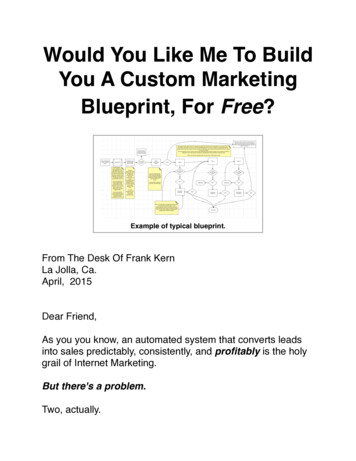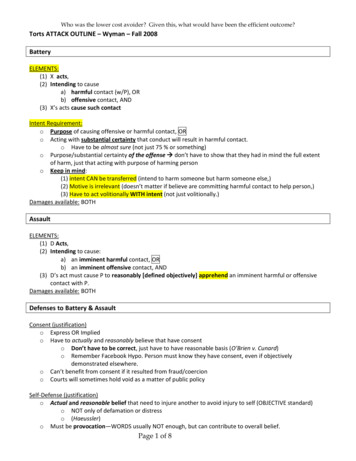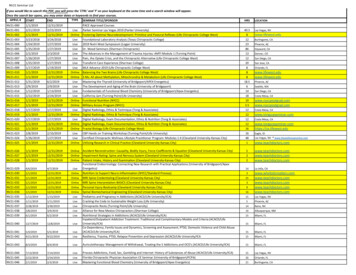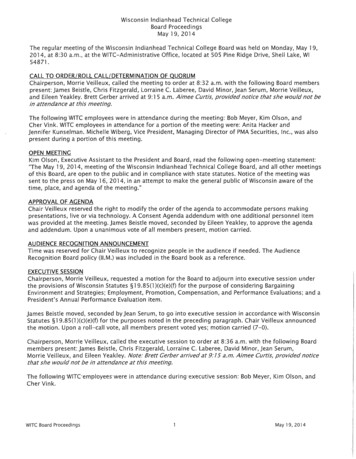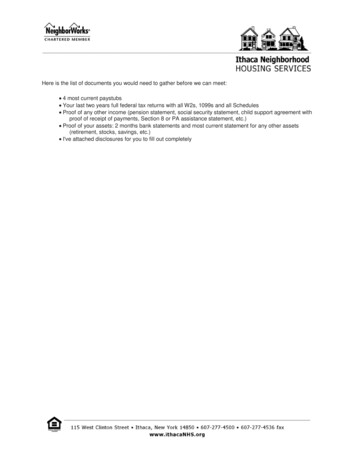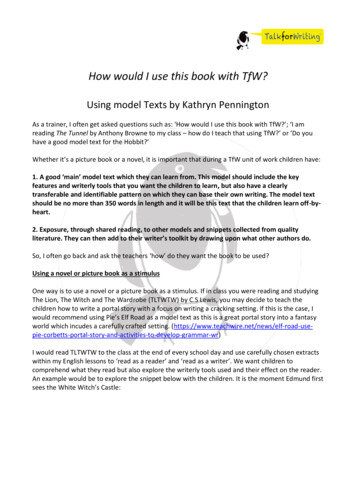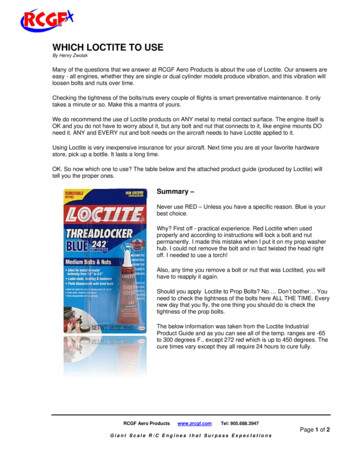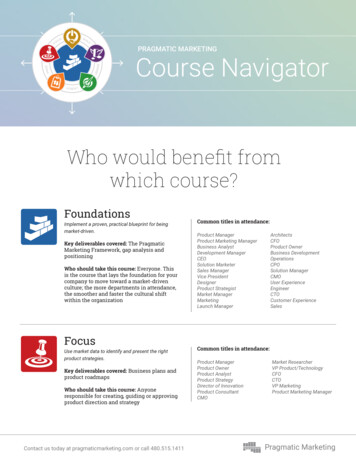
Transcription
PRAGMATIC MARKETINGCourse NavigatorWho would benefit fromwhich course?FoundationsImplement a proven, practical blueprint for beingmarket-driven.Key deliverables covered: The PragmaticMarketing Framework, gap analysis andpositioningWho should take this course: Everyone. Thisis the course that lays the foundation for yourcompany to move toward a market-drivenculture; the more departments in attendance,the smoother and faster the cultural shiftwithin the organizationFocusUse market data to identify and present the rightproduct strategies.Key deliverables covered: Business plans andproduct roadmapsWho should take this course: Anyoneresponsible for creating, guiding or approvingproduct direction and strategyContact us today at pragmaticmarketing.com or call 480.515.1411Common titles in attendance:Product ManagerProduct Marketing ManagerBusiness AnalystDevelopment ManagerCEOSolution MarketerSales ManagerVice PresidentDesignerProduct StrategistMarket ManagerMarketingLaunch ManagerArchitectsCFOProduct OwnerBusiness DevelopmentOperationsCPOSolution ManagerCMOUser ExperienceEngineerCTOCustomer ExperienceSalesCommon titles in attendance:Product ManagerProduct OwnerProduct AnalystProduct StrategyDirector of InnovationProduct ConsultantCMOMarket ResearcherVP Product/TechnologyCFOCTOVP MarketingProduct Marketing ManagerPragmatic Marketing
BuildAlign product and development teams to buildremarkable products.Key deliverables covered: Prioritized projectlist/backlog and requirements/user storiesWho should take this course: Anyoneresponsible for writing, prioritizing, workingwith or consuming requirementsMarketFocus your team on the marketing strategies thatdeliver results.Key deliverables covered: Buyer profiles, buyerjourney maps and marketing plansWho should take this course: Anyoneresponsible for setting go-to-market strategiesLaunchEnsure that launches are effectively planned,executed, supported and measured across theorganization.Key deliverables covered: Launch plans, salesenablement tools and channel trainingCommon titles in attendance:Product ManagerProduct OwnerBusiness AnalystScrum MasterDevelopmentEngineeringTechnical Product ManagerArchitectTechnical ServicesTechnology StrategistUX DesignerResearch & DevelopmentQuality AssuranceCommon titles in attendance:Product Marketing ManagerMarketing CommunicationsSolution MarketersIndustry ManagersVertical MarketersCMOMarketing SpecialistBrand ManagerMarketing ManagerCorporate CommunicationsProduct ManagerCommon titles in attendance:Product Marketing ManagerProduct ManagerSales ManagementSales OperationsChannel MarketingSales EngineerMarketing Comm. ManagerCorporate CommunicationsMarketing SpecialistBusiness DevelopmentMarketing ManagerProject ManagerWho should take this course: Anyonewith product launch or sales enablementresponsibilitiesPriceSet the right price for each product in the market.Key deliverables covered: pricing structure,packaging options and pricing plansCommon titles in attendance:Product ManagerProduct Marketing ManagerSales ManagementSales OperationsFinancial AnalystPricing SpecialistOperationsProduct StrategyWho should take this course: Anyone whomakes or influences pricing decisionsStill not sure what course to take? Go to pragmaticmarketing.com/NavigatorContact us today at pragmaticmarketing.com or call 480.515.1411Pragmatic Marketing
FoundationsTotal Hours: 7.5Lecture: 5.0Group Discussion: 0.5Breaks: 1.5Course Exam: 0.5Course Prerequisite:NoneCOURSE DESCRIPTIONThis course introduces students to the importance of being market-driven. It emphasizes how todevelop an understanding of your market and effectively share that information throughout theorganization. Students learn how to become market-driven by exploring concepts such as how touncover strategic opportunities, define product team roles and responsibilities, prioritize actualvs. desired business goals and how to talk to and observe the market in action. Other topicsinclude: win/loss analysis, distinctive competencies, competitive landscape, innovation, buyerand user personas and positioning.RATIONALEThe purpose of this 7.5–hour course is to provide students with an overview of the importance ofbeing a market-driven organization. As a foundational course, students will gain their first exposureto the Pragmatic Marketing methodology and framework through a lecture and group discussionformat. Core concepts include: fundamentals of Pragmatic Marketing; finding, identifying andevaluating market segments; positioning; competitive and technology assessment; effectiveapproaches to innovation.COURSE OBJECTIVESAt the successful completion of this course, each student will be able to: Understand the need to be market-driven and how to create a1market-driven organization. Prepare a gap analysis of core roles, responsibilities and activities’ actual2vs. desired state. Identify and report market problems through qualitative research methodologies3including conducting win/loss analysis and market visits.4Examine an organization’s distinctive competencies and technology solutions.5 Perform market definition activities including market segmentation and targetmarket identification.6 Discuss the importance of innovation and techniques that can be used to achieveinnovation in the product development process.7 Describe the difference between buyer and user personas and apply thisinformation in the development of effective product positioning.1/4
FoundationsTEXTBOOK and/or MATERIALSStudent Book: Foundations Author: Pragmatic MarketingStudent Supplemental Materials: Pragmatic Marketing Framework Pragmatic Marketing Gap Analysis Example Win/Loss Interview Questions Interview Matrix Worksheet Onsite Call Report Template Product Manager Call Report Example Segmentation Worksheet Solution Matrix Affinity Mapping Example Positioning Document Template Positioning Document Examples Technology Case Study Action PlanTOPICAL UNIT OUTLINEI.Fundamentals of Pragmatic MarketingA. Product and marketing team challengesB. Making decisions using a market-driven approachC. Market data sourcesD. Organizational role and responsibility analysisII. Find Market ProblemsA. Uncover market problemsB. Report market problemsC. Buyer and user personasIII. Identify OpportunitiesA. Filter opportunitiesB. Market segmentationC. Distinctive competenciesD. Competitive landscapeE. Portfolio alignmentIV. PositioningA. Positioning processi. Market problem-centricii. Persona-specificiii. Industry-specificV. InnovateA. Manage riskB. Balance vision, buying/using criteria and the competitionC. Buy, build or partnerD.Technology assessment2/4
FoundationsUNIT OBJECTIVESI.Fundamentals of Pragmatic MarketingA. U nderstand common challenges faced by product and marketing teamsB. Define a market-driven approach for decision makingC. Identify and analyze all sources of market dataD. Assess organizational roles and responsibilitiesE. Perform a gap analysis comparing actual vs. desired performanceII. Find Market ProblemsA. Engage the market to uncover market problemsi. Perform and report market observationsii. Perform and report win/loss analysisB. Document and report market problemsC. Understand buyer and user personasI.Identify OpportunitiesA. Leverage multiple filters to maximize investment opportunitiesB. Understand market segmentation and identify target marketsC. Identify distinctive competenciesD. Evaluate competitive landscapeE. Ensure portfolio alignment with customer impact and depth of investmentII. PositioningA. Understand the positioning process and the results it producesi. Develop positioning focused on market problemsii. Cater positioning to specific personasiii. Cater positioning to specific industriesIII. InnovateA. Learn methods for encouraging innovation while reducing riskB. Understand how to balancing vision, buying/using criteria and the competitionC. Categorize your solutions according to customer impact and depth of investment3/4
FoundationsCOURSE REQUIREMENTS/EVALUATIONUpon successful completion of the course, students will have moved from the knowledge ofcourse materials to cognition and application relative to understanding the importance of beingmarket-driven. Also, students are required to participate in group discussions and successfullycomplete the certification exam associated with the tand the need to be market-driven and howto create a market-driven organization.Class participation,group discussion,course exam.Prepare a gap analysis of core roles, responsibilitiesand activities’ actual vs. desired state.Course exam andclass participation.Identify and report on uncovering market problemsthrough qualitative research methodologies.Class participation,group discussion,course exam.Examine an organization’s distinctive competenciesand technology solutions.Course exam andclass participation.Perform market definition activities including marketsegmentation and target market identification.Course exam andclass participation.Know how to critically evaluate buy, build andpartner strategies.Course exam andclass participation.Discuss the importance of innovation and techniquesthat can be used to achieve innovation in the productdevelopment process.Course exam andclass participation.Describe the difference between buyer anduser personas and apply this information in thedevelopment of effective product positioning.Course exam andclass participation.
FocusTotal Hours: 7.5Lecture: 4.5Lab: 1.0Breaks: 1.5Course Exam: 0.5Course Prerequisite:FoundationsCOURSE DESCRIPTIONThis course teaches students to how to find market opportunities and convert those opportunitiesinto strategic product plans. It emphasizes how to uncover market segments that representthe best investment for a company’s resources and how to effectively share that informationthroughout the organization. Students gain a deep understanding of concepts such as howto identify strategic opportunities and validate alignment with corporate objectives, as wellas how to formulate effective business plans and competitive strategies. Other topics include:positioning; market discovery and validation; market sizing; product portfolio management;measuring profitability; buy, build and partner strategies; distribution strategies; and roadmapdevelopment and communication.RATIONALEThe purpose of this 7.5–hour course is to provide students with an in-depth understanding ofspecific topics within the overall Pragmatic Marketing curriculum. Through a lecture and labformat, students will learn the key components of how to understand your market and how touse that market data to drive product and business planning. Core concepts include: marketdiscovery and validation; competitive assessment; business strategy and investment alignment;positioning; business planning; persona-based distribution strategies; market sizing; productportfolio management and how to build internal and external roadmaps.COURSE OBJECTIVESAt the successful completion of this course, each student will be able to:1 Convert market data into strategic business and product plans.2Identify and analyze the right opportunities for investment.3 Know how to evaluate the competitive landscape and formulate strategiesbased on market position.4Develop product positioning documents.5Examine an organization’s pricing, profitability and product portfolios.6Apply buyer and user personas to distribution strategies.7 Effectively share product vision and roadmaps with both internal andexternal audiences.1/4
FocusTEXTBOOK and/or MATERIALSStudent Book: FocusAuthor: Pragmatic MarketingStudent Supplemental Materials: Pragmatic Marketing Framework Strategy Matrix Competitive Landscape Competitive Information Template Competitive Analysis Worksheet Competitive Write-Up Template Solution Matrix Positioning Document Affinity Mapping ExampleI.Analyze the OpportunitiesA. Identify strategic business goalsB. Assess competitive landscapeC. Analyze investment opportunitiesII. PositioningA. Create positioning documentationi. Overall problem statementii. Ideal solutioniii. Primary messageiv. Product descriptionIII. Propose to the BusinessA. Business planB. Market discovery and validationC. Market sizingD. PricingE. Product profitabilityF. Key performance indicatorsG. Buy, build or partner decisionsH. DistributionI. Portfolio managementJ. Project evaluationIV. CommunicateA. Internal roadmapsB. External roadmaps2/4 Positioning ExampleTechnology Case StudyBusiness Proposal TemplateBuy/Build/Partner WorksheetKey Performance IndicatorsProject Evaluator WorksheetBusiness Plan TemplateInternal Roadmap TemplateExternal Roadmap TemplateAction Plan
FocusUNIT OBJECTIVESI.Analyze the OpportunitiesA. Assess market opportunities and align to business strategyB. Assess competitive landscape; formulate and document competitive strategyC. A nalyze investment opportunities based on market impact and investment requiredII. PositioningA. Create positioning documentation as a corporate communication tooli. State the market problemii. Describe the ideal solutioniii. Create the primary messageiv. Provide a product descriptionv. Affinity map market problemsIII. Propose to the BusinessA. Create business proposal and planB. Discover and validate market problemsC. Estimate and document market sizeD. Determine correct ways to price productsE. Estimate product profitabilityF. Create key performance indicatorsG. Determine buy, build or partner strategiesH. Utilize personas to drive distribution strategyI. Develop portfolio management strategyJ. Evaluate projects based on financial impact and strategic fitIV. CommunicateA. Create and share internal roadmapsB. Create and share external roadmaps3/4
FocusCOURSE REQUIREMENTS/EVALUATIONUpon successful completion of the course, students will have moved from the knowledge ofcourse materials to cognition and application relative to understanding the importance of effectivebusiness planning. Also, students are required to participate in a group lab and successfullycomplete the certification exam associated with the t market data into strategicbusiness and product plans.Course exam andclass participation.Identify and analyze the right opportunities forinvestment.Course exam andclass participation.Know how to evaluate the competitive landscape andformulate strategies based on market position.Course exam andclass participation.Develop product positioning documents.Class participation,lab exercise, courseexam.Examine an organization’s pricing, profitability andproduct portfolios.Course exam andclass participation.Apply buyer and user personas to distribution strategies.Course exam andclass participation.Effectively share product vision and roadmaps withboth internal and external audiences.Course exam andclass participation.
Key deliverables covered: The Pragmatic Marketing Framework, gap analysis and positioning Who should take this course: Everyone. This is the course that lays the foundation for your company to move toward a m


